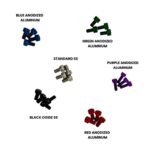Are you experiencing frustratingly short battery life in your Alfa Romeo Giulia key fob? It’s a common concern for Giulia owners, where the key fob battery seems to drain much faster than expected. You might find yourself needing to replace the CR2032 battery frequently, perhaps even as often as every few weeks. Let’s delve into the reasons behind this issue and explore effective solutions to maximize your Alfa Romeo Giulia Key Fob Battery life.
One of the primary culprits for rapid battery depletion in your Giulia key fob is the Passive Entry system. This convenient feature allows you to unlock your car simply by approaching the door handle, without needing to press any buttons on the fob. However, this constant readiness for passive entry puts a continuous, albeit small, drain on the key fob battery.
Even when your key fob is not actively being used to open doors or start the car, it’s not truly “off.” The key fob is designed to periodically communicate with the car’s High Frequency Module. This module constantly listens for your key fob’s signal, especially when you are near the vehicle. This communication loop, essential for passive entry, keeps the key fob in a state of low-power “listening” mode, which consumes battery power over time.
To illustrate the power consumption, consider measurements taken from a Giulia key fob. In an idle state, the key fob consumes approximately 4.9 microAmperes (µA). While this may seem like a tiny amount, it’s a continuous drain. A standard CR2032 battery, typically rated at 200mAh (milliampere-hours) of capacity, would theoretically last for around two years under such a minimal idle current draw.
However, the real battery drain occurs when you interact with the key fob, especially when pressing buttons. Pressing a button to lock, unlock, or open the trunk significantly increases current consumption. Measurements show that pressing a button can spike the current draw to over 5 milliamperes (mA) for a short duration. This pulsed high current, necessary for transmitting the radio signal to your Alfa Romeo, puts a strain on the CR2032 battery and contributes to a shorter overall lifespan.
Considering typical usage, such as opening your car doors several times a day, these high current bursts add up. Calculations suggest that in a normal use scenario, you might expect a Giulia key fob battery life closer to ten months, significantly less than the theoretical two years based on idle current alone. If you frequently use the buttons or live in an area with strong radio interference that might cause the fob to transmit more often, the battery life could be even shorter.
Solutions to Extend Your Alfa Romeo Giulia Key Fob Battery Life:
-
Use Fresh, High-Quality Batteries: Expired or low-quality CR2032 batteries will exacerbate the problem. Ensure you are using fresh batteries with a long expiration date, preferably from reputable brands like Energizer or Duracell. Check the expiration date printed on the battery packaging.
-
Minimize Button Presses: While convenient, try to rely on passive entry as much as possible and reduce unnecessary button presses on your key fob.
-
Consider Battery Removal for Spare Fob: If you have a second key fob that you rarely use, consider removing the CR2032 battery from it to preserve its life until needed. Store the battery in a safe place and re-install it when you decide to use the spare fob.
-
Monitor for “Key Not Recognized” Messages: Pay attention to any messages on your Giulia’s instrument panel indicating “key not recognized” or passive entry failures. These can be early warning signs of a weakening key fob battery.
By understanding the power demands of your Alfa Romeo Giulia key fob and implementing these simple tips, you can optimize the battery life and reduce the frequency of battery replacements. Remember to always use the correct CR2032 battery type and dispose of old batteries responsibly.
